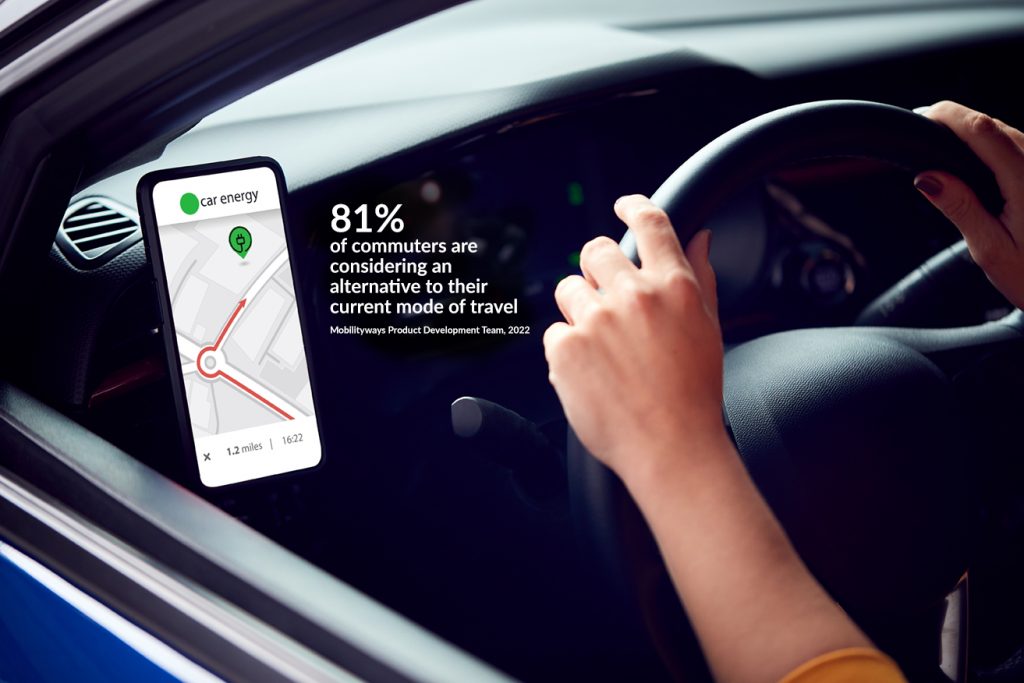By Mel Horton, Managing Partner.
Visioning a change and delivering it – what does it take?
With employees feeling the pressure of inflation and rising costs in every part of their lives the work commute is under the spotlight. Employees are making difficult choices on how they manage increasingly pressured household budgets and consequently finding the lowest cost solution for travel has become more important. In a recent survey by the sustainable travel enterprise Mobilityways we learned 81% of commuters are considering an alternative to their current mode of travel (Mobilityways Product Development Team, 2022). The post pandemic great behaviour change has the power to shape commuting habits long into the future. Add to that the wider debate on protecting the planet and the desire of employees to work for proactive organisations who take their carbon zero responsibilities seriously and you have a powerful equation for change.
Forward looking employers are therefore presented with an excellent opportunity to embrace this moment and implement sustainable commuting initiatives. But what does it take to get a sustainable travel plan off the ground in a large organisation? The short answer is a determined and resilient leader or small group, empowered by a sponsor prepared to back them. And backing them means championing their cause with relevant stakeholders and resourcing the initiative appropriately with people, finance, access to experts and employees. Only then can they build, launch, and have employees adopt motivating credible alternatives to the single car driver commuting norm.

Navigating the decision-making maze in corporations – five pillars for success
Once the vision of a sustainable travel plan is on the table, however sophisticated and descriptive at the outset, somebody needs to turn that vision into a reality. An idea for a green travel plan will become shuttle buses, car sharing, bring your cycle to work schemes and public transport to meet the needs of employees and the employer. Introducing the resilient leader and their small support team if available. They are going to be busy getting agreements and the foundations in place to launch new services to their work community. So, what, broadly will they be doing? In our experience there are 5 pillars for success.
- Leadership or Governance alignment.
- Sustainable Commuting needs and matching supplier offers.
- Specialist permissions.
- Launch Effectiveness.
- Adoption and Change in the target audience.
Leadership or Governance alignment
The team will be working with the sponsor or group of decision makers on the proposed solutions, bringing viable proposals, revising them in line with feedback and getting sign off. Once the plan has been agreed, focus moves to execution and keeping the Sponsor appraised of any major changes or risks along the way. The frequency and content of the updates will depend on the size and complexity of the organisation, and the proposed sustainable travel plan solutions. Monthly or quarterly formal updates to Governance are common with more frequent Sponsor check ins to maintain alignment and progress on the initiative. The work is often iterative – if the plan deviates significantly from what’s been signed off, the team may need to update the Governance to ensure they manage expectations and get further approval to their plan.

Sustainable Commuting needs and matching supplier offers
Once the project has been briefed there will be a lot of scoping and preparation before a proposal can be brought to Governance. Partnering with external agencies can be very helpful at this stage to look at the major transport options and potential solutions and providers. They can also help with employee surveys to understand current travel habits and sentiment on the work commute. Gathering the right data to benchmark the as is situation so that improvements can be measured is very valuable and often only thought about much closer to launch when there is discussion about how to measure the results.
Whilst you won’t be able to contract with potential providers at this stage talking with them to get their input is vital. Don’t fall into the trap of promising something to Governance or employees that a supplier can’t deliver. Scoping is critical for success and putting needs and sensible constraints at the heart of your thinking is vital. People don’t adopt unworkable solutions!
Specialist permissions
So, you’ve done your scoping and have Governance approval – what’s next? It’s highly likely your Governance approval came with lots of caveats and strings attached. Have you checked with legal? What about HR? You’ll need to route this through Procurement and get 3 quotes, have you got this budgeted and are Finance aware? Have IT looked at the platform and checked the data handling and privacy implications? Success now depends on enlisting a much wider group of specialist stakeholders to refine your proposal, put in place checks and approvals and sign it off.
This due diligence will require regular 3-way conversations between you, the specialist function, and the potential provider as you work through your list of questions. Don’t underestimate how long this phase can take. Use regular check ins to drive progress and escalate within the function or to Governance in partnership with your specialist function if things look like they are getting stuck. Once this work is complete its usually back to Governance to get final approval to launch.
Launch Effectiveness
It’s time to think about the best way to tell your community about the sustainable Commuting Solutions you’re planning to launch. There’s a real need to manage expectations here – progress updates are great but don’t promise services until you are confident everything is signed off. When thinking about the launch you’ll want to consider things like the best timing, mechanism, audiences and how to reach them, communication channels, any incentives, and promotions you want to offer to support the launch and materials and assets like Digital posters, information sites, signage and FAQ’s.
An appreciation of any change impacts along with understanding what it will take to adopt the initiatives will guide you on how much help people will need to get on board. Creating a launch plan with plenty of reach into different communication channels as well as having your sponsor actively promote and support the initiative will also help you succeed.

Adoption and Change in the target audience
Clear signalling of how to engage and what to do in simple steps will help your community adopt the change. You’ll need to think about how to support them through the steps to adoption – consideration, enquiry, sign up, activation, trial, adoption.
Connecting with sustainability champions within the organisation to help you promote the solution to their community is helpful. This should happen throughout the initiative as sense checking proposals with them can help avoid foreseeable issues at launch. Creating interventions and where possible a physical presence to offer help will help you enlist early adopters and anyone struggling with the technology.
In the longer term you’ll need to keep the community updated with news and service updates. Putting in place a coordinator resource who owns this and a leader who is accountable for ongoing review and development makes a sustainable commuting initiative truly sustainable. You’ll need to review and tweak in the early days – optimising bus route timings, continuing recruitment drives for lift sharing platforms, linking into wider campaigns on sustainability in the organisation. It’s also time to start tracking the adoption measures you’ve put in place. You can use these both for zero carbon reporting and to create publicity about your success.
Implementing Sustainable Commuting Initiatives: Change Management for Success
When it comes to Sustainable Commuting initiatives, turning ideas into action is a serious commitment. Being choiceful about the size of your programme and how many components you can realistically deliver is important. What will it take in terms of resources and does your organisation have the bandwidth to engage with adoption? At James and Carmichael, we specialise in enabling leaders to deliver ambitious change. We put people at the heart of change and believe great initiatives build ownership and energise people to work better together, make insight driven decisions, embrace new behaviours and deliver results. With the stakes for the future of our planet so high, can you afford not to get behind sustainable commuting in your organisation? If you’d like a partner in that journey who will help you land change, not just talk about it, why not talk to us? info@jamesandcarmichael.com
Mel presented this insight at MobilityWaysZC3Zero Carbon Commuting Conference in October 2022
Reference List
Mobilityways Product Development Team (2022). Cost of living and commuter trends – Mobilityways. [online] Mobilityways.com. Available at: https://www.mobilityways.com/insights/cost-of-living-and-commuter-trends/ [Accessed 24 Oct. 2022].


